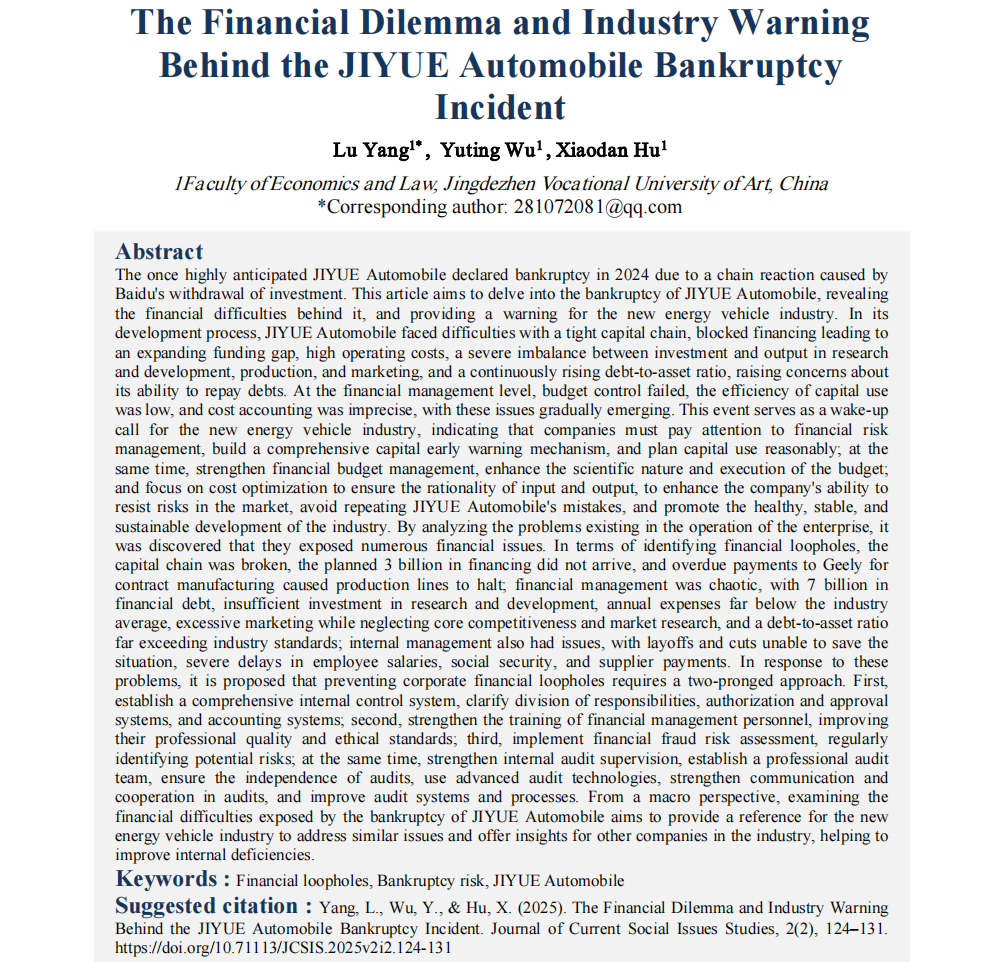The Financial Dilemma and Industry Warning Behind the JIYUE Automobile Bankruptcy Incident
DOI:
https://doi.org/10.71113/JCSIS.2025v2i2.124-131Keywords:
Financial loopholes, Bankruptcy risk, JIYUE AutomobileAbstract
The once highly anticipated JIYUE Automobile declared bankruptcy in 2024 due to a chain reaction caused by Baidu's withdrawal of investment. This article aims to delve into the bankruptcy of JIYUE Automobile, revealing the financial difficulties behind it, and providing a warning for the new energy vehicle industry. In its development process, JIYUE Automobile faced difficulties with a tight capital chain, blocked financing leading to an expanding funding gap, high operating costs, a severe imbalance between investment and output in research and development, production, and marketing, and a continuously rising debt-to-asset ratio, raising concerns about its ability to repay debts. At the financial management level, budget control failed, the efficiency of capital use was low, and cost accounting was imprecise, with these issues gradually emerging. This event serves as a wake-up call for the new energy vehicle industry, indicating that companies must pay attention to financial risk management, build a comprehensive capital early warning mechanism, and plan capital use reasonably; at the same time, strengthen financial budget management, enhance the scientific nature and execution of the budget; and focus on cost optimization to ensure the rationality of input and output, to enhance the company's ability to resist risks in the market, avoid repeating JIYUE Automobile's mistakes, and promote the healthy, stable, and sustainable development of the industry. By analyzing the problems existing in the operation of the enterprise, it was discovered that they exposed numerous financial issues. In terms of identifying financial loopholes, the capital chain was broken, the planned 3 billion in financing did not arrive, and overdue payments to Geely for contract manufacturing caused production lines to halt; financial management was chaotic, with 7 billion in financial debt, insufficient investment in research and development, annual expenses far below the industry average, excessive marketing while neglecting core competitiveness and market research, and a debt-to-asset ratio far exceeding industry standards; internal management also had issues, with layoffs and cuts unable to save the situation, severe delays in employee salaries, social security, and supplier payments. In response to these problems, it is proposed that preventing corporate financial loopholes requires a two-pronged approach. First, establish a comprehensive internal control system, clarify division of responsibilities, authorization and approval systems, and accounting systems; second, strengthen the training of financial management personnel, improving their professional quality and ethical standards; third, implement financial fraud risk assessment, regularly identifying potential risks; at the same time, strengthen internal audit supervision, establish a professional audit team, ensure the independence of audits, use advanced audit technologies, strengthen communication and cooperation in audits, and improve audit systems and processes. From a macro perspective, examining the financial difficulties exposed by the bankruptcy of JIYUE Automobile aims to provide a reference for the new energy vehicle industry to address similar issues and offer insights for other companies in the industry, helping to improve internal deficiencies.
Downloads
References
[1]Bernstein, S., Colonnelli, E., Giroud, X., & Iverson, B. (2019). Bankruptcy spillovers. Journal of Financial Economics, 133(3), 608–633.
[2]Georgiadis, G., & Mehl, A. (2015). Trilemma, not dilemma: financial globalisation and Monetary policy effectiveness. Globalization and Monetary Policy Institute Working Paper, 222.
[3]Korejo, M. S., Rajamanickam, R., Md. Said, M. H., & Korejo, E. N. (2023). Plea bargain dilemma, financial crime and asset recovery. Journal of Money Laundering Control, 26(3), 628–639.
[4]Kraft, A. G., Vashishtha, R., & Venkatachalam, M. (2018). Frequent financial reporting and managerial myopia. The Accounting Review, 93(2), 249–275.
[5]Le, N., & Ngo, P. T. H. (2022). Intra‐industry spillover effects: Evidence from bankruptcy filings. Journal of Business Finance & Accounting, 49(7–8), 1113–1144.
[6]Li, M., & Zhu, C. (2024). The Impact of Accidental Shocks on Asset Prices from the Perspective of Financial Industry Opening. Theoretical Economics Letters, 14(4), 1455–1477.
[7]Sumner, S. B. (2015). The Midas paradox: financial markets, government policy shocks, and the great depression. Independent institute.
[8]Tyers, R., & Bain, I. (2008). American and European financial shocks. CHINA’S DILEMMA, 30.
[9]Zou, M., & Wu, W. (2020). Research on manager’s overconfidence and enterprise financial dilemma: a case analysis based on leeco company. 1st Africa-Asia Dialogue Network (AADN) International Conference (AADNIC 2019), 14–19.
[10]Ingrassia, P. (2011). Crash Course: The American Automobile Industry’s Road to Bankruptcy and Bailout-and Beyond. Random House Trade Paperbacks.
[11]Jasinski D, Meredith J, Kirwan K. A comprehensive review of full cost accounting methods and their applicability to the automotive industry[J]. Journal of Cleaner Production, 2015, 108: 1123-1139.
[12]Agus A, Krishnan S K, Kadir S L S A. The structural impact of total quality management on financial performance relative to competitors through customer satisfaction: a study of Malaysian manufacturing companies[J]. Total quality management, 2000, 11(4-6): 808-819.

Downloads
Published
How to Cite
Issue
Section
License
Copyright (c) 2025 Lu Yang, Yuying Wu, Xiaodan Hu

This work is licensed under a Creative Commons Attribution 4.0 International License.






















